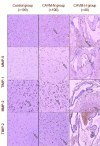Imbalance of matrix metalloproteinase-9 and matrix metalloproteinase tissue inhibitor-1 may contribute to hemorrhage in cerebellar arteriovenous malformations
- PMID: 25657688
- PMCID: PMC4308784
- DOI: 10.3969/j.issn.1673-5374.2012.19.011
Imbalance of matrix metalloproteinase-9 and matrix metalloproteinase tissue inhibitor-1 may contribute to hemorrhage in cerebellar arteriovenous malformations
Abstract
In this study, we determined the expression levels of matrix metalloproteinase-2 and -9 and matrix metalloproteinase tissue inhibitor-1 and -2 in brain tissues and blood plasma of patients undergoing surgery for cerebellar arteriovenous malformations or primary epilepsy (control group). Immunohistochemistry and enzyme-linked immunosorbent assay revealed that the expression of matrix metalloproteinase-9 and matrix metalloproteinase tissue inhibitor-1 was significantly higher in patients with cerebellar arteriovenous malformations than in patients with primary epilepsy. The ratio of matrix metalloproteinase-9 to matrix metalloproteinase tissue inhibitor-1 was significantly higher in patients with hemorrhagic cerebellar arteriovenous malformations compared with those with non-hemorrhagic malformations. Matrix metalloproteinase-2 and matrix metalloproteinase tissue inhibitor-2 levels were not significantly changed. These findings indicate that an imbalance of matrix metalloproteinase-9 and matrix metalloproteinase tissue inhibitor-1, resulting in a relative overabundance of matrix metalloproteinase-9, might be the underlying mechanism of hemorrhage of cerebellar arteriovenous malformations.
Keywords: cerebellar arteriovenous malformations; enzyme-linked immunosorbent assay; hemorrhage; immunohistochemistry; matrix metalloproteinase-2; matrix metalloproteinase-9; neural regeneration; tissue matrix metalloproteinase inhibitor-1; tissue matrix metalloproteinase inhibitor-2.
Conflict of interest statement
Figures

Similar articles
-
Relevance of IL-6 and MMP-9 to cerebral arteriovenous malformation and hemorrhage.Mol Med Rep. 2013 Apr;7(4):1261-6. doi: 10.3892/mmr.2013.1332. Epub 2013 Feb 20. Mol Med Rep. 2013. PMID: 23426918
-
Using urinary bFGF and TIMP3 levels to predict the presence of juvenile pilocytic astrocytoma and establish a distinct biomarker signature.J Neurosurg Pediatr. 2016 Oct;18(4):396-407. doi: 10.3171/2015.12.PEDS15448. Epub 2016 Jun 17. J Neurosurg Pediatr. 2016. PMID: 27314542
-
Coexpression of angiogenic factors in brain arteriovenous malformations.Neurosurgery. 2005 May;56(5):1058-65; discussion 1058-65. Neurosurgery. 2005. PMID: 15854255
-
Response of plasma matrix metalloproteinases and tissue inhibitor of metalloproteinases to stent-graft surgery for descending thoracic aortic aneurysms.J Thorac Cardiovasc Surg. 2007 Oct;134(4):925-31. doi: 10.1016/j.jtcvs.2007.05.044. J Thorac Cardiovasc Surg. 2007. PMID: 17903509
-
Matrix metalloproteinases and tissue inhibitors of metalloproteinases in loose artificial hip joints.Clin Orthop Relat Res. 1998 Jul;(352):35-45. Clin Orthop Relat Res. 1998. PMID: 9678031 Review.
Cited by
-
The impact of sleep problems on cerebral aneurysm risk is mediated by hypertension: a mediated Mendelian randomization study.Front Genet. 2024 Oct 11;15:1434189. doi: 10.3389/fgene.2024.1434189. eCollection 2024. Front Genet. 2024. PMID: 39464793 Free PMC article.
References
-
- Yasargil MG. New York: Georg Thieme Verlag; 1987. Microneurosurgery. IIIA: AVM of the brain, history, embryology, pathological considerations, hemodynamics, diagnostic studies, microsurgical anatomy.
-
- Hashimoto T, Wen G, Lawton MT, et al. Abnormal expression of matrix metalloproteinases and tissue inhibitors of metalloproteinases in brain arteriovenous malformations. Stroke. 2003;34(4):925–931. - PubMed
-
- Liu ZK, Lin ZM, Xu HZ, et al. Relationship between matrix metalloproteinase 9 and cerebral vascular malformations. Jilin Yixue. 2011;32(16):3175–3177.
-
- Kranzhöfer A, Baker AH, George SJ, et al. Expression of tissue inhibitor of metalloproteinase-1, -2, and -3 during neointima formation in organ cultures of human saphenous vein. Arterioscler Thromb Vasc Biol. 1999;19(2):255–265. - PubMed
-
- Liu ZK, Lin ZM, Xu HZ, et al. Relation between matrix metalloproteinase 2 and cerebral vascular malformations. Jilin Yixue. 2011;32(19):3887–3888.
LinkOut - more resources
Full Text Sources
Research Materials
